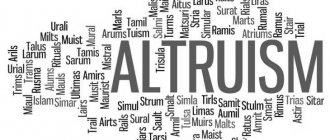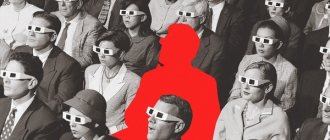Hello, dear readers of the KtoNaNovenkogo.ru blog. Who are the marginalized anyway, to put it simply? People who, of their own free will, did not want to be part of society, or were they kicked out by society?
Or are these the people who are just standing next to the company on the side? Such a sensational word, but not everyone knows exactly what this concept means. I'll say more. The meaning of this word is quite vague. Many people understand when and to whom it can be applied, but they cannot give a definition. But you and I will try.
Who is a marginalized person: definition of the term
In its original form, this concept came from sociology, but subsequently moved into other areas: psychology, social science, etc. This is why it is so important to determine the real meaning of the word marginal. A marginal personality is usually understood as a person cut off from any social group. Such people have a number of sociological and behavioral characteristics that justify their separation into a special system.
Marginal is an asocial object, which is not necessarily equivalent to dysfunctional, immoral or suffering from pathological attachments and bad habits.
This term first appeared in the United States in the 1920s in relation to people freed from slavery who, thanks to freedom, left one social group, but did not have time to adapt to any other. A large number of marginalized people also emerged during the period of urbanization, when young people began to abruptly leave their native villages and move to big cities. Today the word marginal is often used in relation to people with a low level of culture, morality and education.
Who are the marginalized and where do they come from?
Who can be classified as a marginalized population?
Those who are called marginalized in today's realities are, in fact, most often lumpen. The unforgettable Karl Marx included beggars, vagabonds, bandits, and degenerate people into this layer of the population.
According to the prevailing stereotype, marginalized people and lumpen people have common interests and lead a similar lifestyle. This is not entirely true.
What is the difference between marginalized people and lumpen people?
Lumpens are morally degraded people who are at one of the stages of degradation and are gradually descending lower and lower, approaching an animal state. The marginalized can be lumpen, but not always. Marginalized are those who do not fit into society, have their own philosophy and lead a lifestyle that is unusual for those around them.
Who can be considered marginalized:
- Voluntary hermits who do not recognize social values (downshifters, freelancers);
- Migrants who were unable to integrate into the cultural environment of the country in which they now live;
- People who left their usual place of life (village residents in the city and vice versa);
- People with physical disabilities or mental illness;
- Carriers of dying national cultures;
- Adherents of bad habits to an extreme degree (gamblers, drug addicts, alcoholics);
- Followers of religious minorities, sectarians;
- Those who belong to radical political movements preach terrorism;
- People who find themselves below the poverty line;
- Those released from prison after a long period of restriction of freedom.
Signs of marginalia
There are several main signs that characterize a marginal personality:
- Severance of economic, social and spiritual ties that exist in the “pre-marginal” period of life. Often this status is assigned to migrants, refugees and military personnel discharged from service. Such people find themselves on the periphery and cannot always adequately adapt to new conditions. Finding himself in such a situation, a person can declassify - fall to the social “bottom”.
- Developing your own value system, and sometimes hostility towards the current society, legislation, etc.
- Mobility – arises due to the lack of housing and attachments.
- Mental and psychological problems that manifest themselves on the basis of unfulfillment.
- Tendency to engage in illegal activities.
The marginal label can be imposed on a person by society or adopted by the individual independently.
Society's attitude
The period of “marginality” of a person may be a temporary phenomenon. This directly depends on favorable events and circumstances in his life. For example, if you arrive in a country with a completely different culture, language, and national-racial characteristics, at first you will become a marginal figure for this society if you have problems with the language and adaptation to the new culture.
But as soon as you adapt to a new society, get rid of the language barrier and get a job, you immediately cease to be a marginal figure for this society, even if you are a representative of a different culture and religious denomination.
The exception is usually people who have become marginalized by force, that is, refugees or those who have consciously chosen this way of life for themselves (these categories include radicals, extremists, revolutionaries and vagabonds).
It turns out that anyone who has chosen their life values and beliefs can become a marginalized person.
How marginalized people influence society
By the way, many scientists from the field of sociology and psychology note that marginalized people make a separate contribution to the growth of culture, giving society new views on familiar things, ideas and setting new trends.
Types of marginalized people
If events develop favorably, the period of marginality for a person lasts relatively short. A strong personality can easily join a new social group, find a job and realize his own needs. The exception is people who became marginalized not of their own free will, but due to some external circumstances (refugees) or those who consciously chose this way of life (extremists, radicals, revolutionaries, etc.). Over the past period of time, sociologists have identified several types of marginality.
Political marginality
The most striking example of political marginality is the rise to power of Fidel Castro in Cuba, accompanied by bloody repression and unrest. The new treasure of life became almost unbearable for more than 2 million men and women who decided to flee to other countries. Thus, refugees were marginalized - they became individuals who did not accept the existing political regime and its laws.
Ethnic marginality
Most often, people born from parents of different nationalities become ethnic marginals. It is important to understand that not every interethnic union gives rise to marginalized people. This phenomenon is observed only when the child does not want to identify himself with any parental nationality. In addition, the ethnic marginalized include:
- national minorities;
- extremely small peoples.
Religious marginality
The majority of people consider themselves to belong to a particular religion or adhere to atheism. A religious fringe is a person who believes in the existence of a higher power, but cannot associate himself with any existing religion. Among such marginalized people you can find people who founded their own church.
Social marginality
Social marginality arises against the backdrop of cataclysms and external factors: social upheavals, wars, natural disasters, etc. Large groups of people instantly lose their social status and are forced to seek it in new conditions.
Economic marginality
The economic marginalized include:
- unemployed;
- people living at the expense of the state or another person;
- men and women who do not want to develop in the professional field.
Today, super-rich people who are cut off from society are also called economic marginals. Thanks to the benefits received, they can often change their place of residence, try themselves in a new field, etc.
Biomarginality
In an ideal system of society, people should take care of those who, for some reason, find themselves in a difficult life situation. Unfortunately, theory often differs from practice, which is why in the modern world there is biological (natural) marginality. This type includes people who do not have a socially useful function and are among the most vulnerable layers: disabled people, old people, chronically ill people, children with syndromes, etc.
Yes
100%
No
0%
Voted: 3
SCIENTIFIC LIBRARY - ABSTRACTS - Social role of marginalized people
Teston the topic of:
“The social role of marginalized people in the formation of social structure”
Volgograd 2004
Content
Introduction
1. The concept of “marginality”
2. The role of marginalized people in the formation of the social structure of the Russian
society
Conclusion
Bibliography
Introduction
The concept of marginality serves to designate the borderline,
peripherality or intermediateness in relation to any social
communities (national, class, cultural).
Marginal person (from Latin Margo - edge) - a person:
- located on the border of different social groups, systems, cultures; And
- influenced by their conflicting norms, values, etc.
A marginal person, simply put, is an “in-between” person. Marginality
(Late Latin marginalis - located on the edge) - a sociological concept,
denoting the intermediate, “borderline” position of a person between
any social groups, which leaves a certain imprint on
his psyche.
The classic, so to speak, standard figure of the marginalized is a person
who came from the village to the city in search of work: no longer a peasant, not yet
worker; the norms of the village subculture have already been undermined, the urban subculture
has not yet been learned. The main sign of marginalization is the breakdown of social ties,
Moreover, in the “classical” case, economic,
social and spiritual connections. When including the marginalized in the new social
commonality, these connections are established in the same sequence, and
the establishment of social and spiritual connections, as a rule, lags far behind
establishing economic ties. The same migrant, having become a worker and
Having adapted to new conditions, for a long time he cannot merge with
new environment.
Unlike the “classical” one, the reverse sequence is also possible
marginalization. Objectively still remaining within this class,
a person loses his subjective characteristics and is psychologically declassed.
After all, declassing is primarily a socio-psychological concept, although
and having economic reasons. The impact of these reasons is not
is direct and immediate: objectively thrown beyond
of the proletariat, an unemployed person in the West will not become a lumpen as long as he maintains
the psychology of the class and, above all, its work morale. In our country we do not have
unemployment, but there are declassed representatives of workers, collective farmers
intelligentsia, administrative apparatus. What is their distinguishing feature?
First of all, in the absence of some kind of professional code of honor.
A professional will not stoop to do his job poorly. Even with
In the absence of material incentives, a real worker cannot work poorly
- he would rather refuse to work at all! Physical impossibility of slacking
distinguishes a professional cadre worker (as well as a peasant and
intellectual) from a declassed scammer and flyer.
This paper will examine the role of marginalized people in the formation
social structure of society.
1. The concept of “marginality”
The concepts of “marginality” and “marginals” come from sociology and political science.
They were introduced into science by the American sociologist R. Park in 1928 and
were first used to designate a very specific ethnocultural
situations when characterizing “personality at the border of cultures”[1].
Marginality in its typical form is the loss of objective
belonging to one or another class, estate, group without subsequent
joining another similar community. The main sign of marginality
serves to break ties (social, cultural, settlement) with the previous
environment. Gradually, the meaning of the term “marginality” began to expand and
now it serves to denote borderland, peripherality or
intermediateness in relation to any social communities. Classic type
marginal - yesterday's peasant in the city - no longer a peasant and not yet
worker. In the classical (positive) version, marginality gradually
overcome by including marginalized people in a new environment and acquiring
new features. Another option for marginalization (negative) is that
the state of transition and peripherality is conserved and preserved
for a long time, and the marginalized bear the traits of the declassed, lumpen,
parasitic behavior. This kind of marginality was declared
the result of vertical mobility with a negative sign, i.e.
a consequence of top-down, downward mobility. It should also
take into account that sociology has developed the concept of types of society: open,
closed and transitional type. It is believed that in open societies
mobility is high, and they are dominated by progressive, upward mobility
movement, and marginality is transient and temporary. IN
In closed societies, mobility is low. The highest degree and
the extent of mobility, and therefore marginality, in societies
transitional type - from closed to open. In such societies, many
years, marginality becomes one of the basic characteristics of displacement
within society.
In relation to the goals and objectives of historical analysis, it is necessary
consider the following points. In any society, including Russian,
on the eve and after the revolution due to objective and subjective reasons
marginal groups existed and reproduced. Marginality can
be natural and artificially created and maintained. ABOUT
natural marginality should be spoken of in relation to processes
economic, social or cultural nature, due to which
Every society has its own “bottom” in the form of the ruined and degraded
elements and groups, as well as antisocial elements - those who are rejected by
society itself. In other words, in every society, open or closed,
stable or transitional, there are peripheral groups with relatively
similar sources of formation, appearance and psychology. May vary
be only the proportion of these groups.
It’s another matter if the process of restructuring in society is delayed, and
marginality becomes excessively widespread and long-term social
phenomenon. In this case, the marginalized acquire the features of a social
stability, “hang” on the breaks in social structures. It happens,
as a rule, as a result of a policy deliberately pursued by the authorities
artificial marginalization, that is, transfer to the peripheral,
discriminatory or restrictive provisions for hundreds of thousands and even
millions of people. For example, even in pre-revolutionary society it was carried out
deliberate policy of marginalization towards political opponents
regime (revolutionaries), as well as those who were discriminated against and
restrictions on national or religious grounds. However, in
post-revolutionary society, artificial marginalization affected entire
categories and population groups. There was a division of society into opponents and
supporters of the regime. Such events arose and were artificially supported by the regime
groups that did not previously exist. Thus, the special settlers did not have
analogues in pre-revolutionary society, but existed in Stalin’s since 1930
to 1955, that is, a quarter of a century. Never before has there been such a troupe as
rear militias are children of the “disenfranchised” who have reached conscription age and
conscripted not into regular units of the Red Army, but into the rear militia -
analogue of the future construction battalion. The group existed from 1930 to 1937. So
Thus, artificial marginalization acquired in Stalinist society
colossal, catastrophic dimensions and became an organic accompanying
element of repression and one of the ways to solve political and even
economic problems (creation of a forced labor system).
Unfortunately, the topic “Marginality and marginalized groups” in relation to
to Russian history of the twentieth century is not sufficiently developed.
First of all, we should highlight the works of sociologists in which
the problems of theory and partly the history of the marginalized of the first
half of the twentieth century. The most complete and qualified theory of the issue together with
excursions into our history are presented in the publications of E. Starikov. To him
priority belongs to the formulation of this problem as a research and
most important for understanding changes in the social structure of the Russian
society in the present century. He also raised the question of the depth and scale
processes of refeudalization of post-revolutionary society. So, E. Starikov
a hypothesis has been formulated that with the destruction of traditional society,
if the new structures fail to quickly consolidate, then the debris
traditional society will be structured earlier, and the newly emerged
the social system will be an order of magnitude lower than the destroyed one, that is, more
archaic. And this applies to all elements of the structure. He is the first among
domestic social scientists put forward a hypothesis about the reconstruction after revolutions
1917 in Russia, the class model of society, although in the new, Soviet
guise.
In a similar vein, the works of M. Voslensky were written, dedicated to
consideration of the formation and development of nomenclature as a special layer.
Voslensky directly states that nomenklatura is a product of declassed
society and the nomenklatura itself is essentially a marginal group.
A number of domestic researchers (N. Ivanova, V. Zhiromskaya, etc.),
analyzing the social structure of the beginning of the century and post-revolutionary years, also
come to the conclusion that when describing the model of structural changes and
shifts without taking into account the processes of mass marginalization to understand the nature
changes in social structure are impossible.
I. Pavlova raised the question of the role of Stalinist repressions in social
transformation of Soviet society. Based on the scale and consequences
state repression, which directly affected a third
capable population and taking into account the fact that significant groups of society
ensured the activities of the punitive machine, the researcher concludes that
violent criminalization and lumpenization of Soviet society.
Among Western researchers the problem should be highlighted translated and
original works by S. Fitzpatrick, where problems of connections are posed
refeudalization and marginality with the state of society and Stalin's
politics. In particular, she paid special attention to the implementation of Stalin's
regime of social policy of forced restructuring of society
by using the previous feudal practice of “attributing” certain
groups into the category of “friends” or “strangers”. When assessing trends
of the social structure of post-revolutionary society, it convincingly proves
inconsistency of Marxist doctrinal statements about class character
society in real practice, which reproduced the class hierarchical
system of relations.
As part of the study of individual marginal groups, it should be noted
the appearance of the first research works devoted to the “disenfranchised” (A.
Dobkin, M. Salamatova, T. Slavko, special settlers (V. Zemskov, N.
Ivnitsky, V. Danilov, etc.), prisoners (V. Zemskov, A. Getty, G.
Rittersporn, V. Popov, etc.). What is characteristic of these publications is that they
in them the central place is given to the analysis of the policies of the Bolshevik regime in
towards marginalized groups. Parameters such as numbers were also noted:
composition, territorial location of these groups. At the same time
sociocultural characteristics (appearance) of these groups still remain
on the periphery of research interests. Regarding categories such as
rear militias and exiles, then at present there are only a few about them
publications of the author of the book.
2. The role of marginalized people in the formation of the social structure of Russian society
The social transformation of society today is characterized not only by
the emergence of previously non-existent strata in the stratification system - before
the entire class of large and medium owners, the layer of “new poor”,
marginalized, unemployed, but also the corresponding adaptation of these layers to again
emerging status-role functions, reorientation of social and personal
identity.
The emphasis over the years has been on different aspects of structural
inequality, its deepening, social polarization and marginalization
society, on the integration and disintegration of social space; on
problems of formation of the middle class; power relations; autonomy
labor in social and production structures.
To get a fairly complete picture of the processes occurring in
social-structural sphere of Russian society, it is necessary to consider
trends and scale of formation of various social elements,
social communities, the dynamics of which are determined by qualitative
changes in property relations, power, in the level of income of various
social groups and strata, the laws of structural restructuring of the economy and
employment of the population. It is known that a certain part of the employed population in
as a result of industry shifts in the country’s economy, the crisis that affected
entire groups of industries remained outside the sphere of employment and acquired the status
unemployed. Today this is 8% of the active population of Russia. The appearance of this
layer significantly affects the overall quality of life of the entire population. But then
At the same time, having changed their employment status, this part of the population formed the features
group certainty with its own value and normative attitudes,
consumption structure, quality and lifestyle, identification
preferences and life values. Thus, the implementation took place
a whole complex of new social group processes, the formation of the phenomenon
group consciousness and group consolidation and integration.
The specificity of Russian society, among other things, is that the process
globalization is superimposed on the contradictory process of transformation,
accompanied by deepening social inequality and marginalization
a significant part of the population. The problem of deepening social inequality in
world literature was called “Brazilification”. The rise of marginalized
layers (in the figurative expression of D. Copeland, “Generation X”) there is also
in Russian society.
The transformation of Russian society inevitably entailed
only changes in the social structure, but also acutely posed
traditional communities the question of awareness of individual and group
social identity, integration and disintegration, place in social
hierarchy, solidarity, level of cohesion, value system[2].
Marginality is now experiencing a very peculiar moment: continuing
count all undesirable elements among its victims, society feels how
its deepest foundations are being undermined from within, thoroughly dis-
shaken by economic processes. Now not only strangers are going into circulation,
but also those who are our own - those who are amazed by those who have settled in our
cancer society. Rejection appears as a product of the collapse of society,
affected by the crisis. The word "marginal" is gradually falling out of use,
since men and women living on the other side of the decorum do not do it themselves
this is a choice - they are imperceptibly pushed into this state, never
without explicitly joining any of the traditional categories
rejection.
Being perhaps weaker than others (although this should still be
prove), they remain on the side of the road along which the traffic continues
a ramming cohort of those who stayed in the saddle, indifferent to how they were lagging behind and
as the marginalized fall.
The marginalized is no longer some kind of stranger or leper. He's like everyone else
identical to them and at the same time he is a cripple among his own kind - a man with
truncated roots, cut into pieces in the very heart of the native culture,
native environment.
Marginalized - designation of individuals and groups located on
“outskirts”, on the “sidelines” or simply outside the framework characteristic of a given
society's main structural divisions or dominant
sociocultural norms and traditions.
Scientists have drawn attention to the fact that in the situation of the marginalized there is
a significant and, moreover, very active part of American society
(ethnic and religious minorities, representatives of non-trivial thinking
artistic and scientific intelligentsia, etc.). It was also noticed that
“marginal” are not only limited in their status positions, but also sometimes
are unable to realize creative potential and thus
enrich society both materially and spiritually.
A marginal situation arises at the boundaries of dissimilar forms
sociocultural experience, is always very intense and different
is implemented in practice. It can be a source of neuroses, demoralization,
individual and group forms of protest. But it can also be a source
new perception and understanding of the Universe and society, non-trivial forms
intellectual, artistic and religious creativity.
A retrospective look at the history of world culture shows that many
renewing trends in the spiritual history of mankind (world religions,
great philosophical systems and scientific concepts, new forms
artistic representation of the world) largely owe their origin to
specifically marginalized individuals and sociocultural environments.
Technological, social and cultural shifts of recent decades
gave the problem of marginality a qualitatively new outline. Urbanization,
mass migrations, intensive interaction between speakers of heterogeneous
etho-cultural and religious traditions, erosion of centuries-old cultural
barriers, the influence of mass communications on the population - all this
led to the fact that marginal status in the modern world has become not so much
exception, as is the norm for the existence of millions and millions of people. On
the turning point of the 70-80s. it became clear that it was no longer possible to express and
defend, using the interests of these huge masses of people and those who stand on their
side of the intelligentsia, the usual forms of social management (state.
institutions, political parties, traditional church hierarchies, etc.).
It was during this period that the world began a rapid process of becoming so
so-called “informal” social movements - educational,
environmental, human rights, cultural, religious, community,
charitable and other movements, the meaning of which is largely related to
connecting the marginalized to modern social life
groups.
Conclusion
Marginality is not a state of autonomy, but the result of conflict with
generally accepted norms, the expression of specific relationships with the existing
social system. Marginality does not arise outside the sharp reality or
a fictional encounter with the outside world.
Going into marginality involves two completely different routes:
- either breaking all traditional ties and creating your own,
a completely different world;
- either gradual displacement (or violent ejection) beyond
legality.
In any case, be it the result of a “free” choice or
a consequence of the process of declassification, which is provoked by a frightened
society, the margin does not mean the underside of the world, but, as it were, its whirlpools,
shadow sides. Society exposes the outcasts to reinforce
your own world, the one that is considered “normal” and bright.
The presence of significant marginalized groups is becoming a serious threat to
public morality, social development of the country.
Bibliography
1. Social stratification of Russian society. Ed. Doctor of Philosophy, Prof.
Golenkova Z.T. "Summer Garden" Moscow 2003
2. Petrov D.V. “The use of the concepts of marginality and liminality in
research of youth subcultures” // Petrov D.V. Youth
subcultures - Saratov, 1996
3. Rozhansky M. “Marginal Russia” // Friendship of Peoples -1998-No. 2
4. Dakhin V. “State and marginalization” // Free Thought 1997 - No. 4
————————
[1] Rozhansky M. “Marginal Russia” // Friendship of Peoples -1998-No. 2. P. 17
[2] Social stratification of Russian society. Ed. Doctor of Philosophy, Prof.
Golenkova Z.T. “Summer Garden” Moscow 2003. P. 9
Pros and cons of marginality
The original meaning of a marginal lifestyle has been somewhat transformed, and therefore carries not only a negative, but also a positive load.
Advantages and disadvantages
Mobility and flexibility
A penchant for innovation and everything new
Enrichment of culture and creation of a new social group
Confusion and inability to act effectively in new circumstances
Some destabilization of society
Inability to adapt to a new role
Loss of former values
Possibility of lumpenization
In most cases, society suffers from marginalization, since this phenomenon is most often associated with any radical changes - revolutions, riots, etc. This can lead to the destabilization of the economy and politics, as well as the outflow of promising and highly intelligent individuals.
Artificially created marginality also carries a negative connotation. In this case, the number of marginalized people will begin to grow exponentially, which will lead to the death and lumpenization of innocent people, in particular small children. Examples of artificial marginalization of society are: the Holocaust of the Jewish nation, as well as Stalinist repressions.
Bottom line
Marginality may seem like a negative quality. However, it has its advantages:
- The ability to see what society does not see.
- The ability to be detached, mobile, easy-going.
- Fearlessness, because the marginalized is not attached to anything.
The negative aspect of marginality is loneliness in the big world of people, where no one understands a person and treats him negatively. Often those around them are subject to stereotyped thinking, which is excluded in the case of the marginalized.
Marginality and poverty
Many people mistakenly believe that marginalized groups include only degraded and impoverished individuals. As noted earlier, such elements may also include super-rich people, who, due to their wealth, become freer than other members of society. Quite often, successful and wealthy businessmen strive for a quieter life, so they conduct business in the city and live in the province or village. This is why marginality cannot be associated with lack of money or imprisonment.
The phenomenon of downshifting is of particular interest in the current structure of society. From birth, a person develops in two directions at once: as a social unit and an individual personality. Ideally, these forces should be in a balanced position, but in reality one of the vectors may outweigh. With increased socialization, a conformist appears, and with increased individualization, a downshifter appears.
A downshifter is a person who has chosen to live outside society or has deliberately limited his social connections outside the family. Such an outcast is quite happy with being in a borderline state, since he can travel freely, live independently of anyone, etc. Downshifters have strong energy and unconventional thinking, so they prefer to engage in creativity and art.
What can a marginal status lead to?
No one will ever be able to say exactly how a person’s adaptation will proceed in a completely new social environment, since it depends on a large number of external and internal factors. But if we consider the most unfavorable scenario, then most likely a conflict situation of a multidirectional nature will arise:
* External - the aggressive attitude of the marginalized in relation to the attacks of society; * Internal - the marginalized person is torn by contradictions due to the fact that he cannot find his place in the new society.
But if they demonstrate their flexibility, skill and desire to adapt to the new society, the marginalized person has every chance of leaving this status as soon as possible, becoming part of the new society.
Examples of famous marginalized people
The most famous outcasts:
- Jesus Christ is a religious marginality.
- Diogenes of Sinope - ancient Greek philosopher.
- Leo Tolstoy denied most of the privileges of the noble class, preferred to live in the countryside and worked in a rather revolutionary direction.
- Emelyan Pugachev - leader of the Peasant War.
It should be noted that marginalized people have existed throughout history. In the modern world, this phenomenon has received a new round of development.
The spread of the Internet has contributed to the formation of a new marginal group of freelancers who prefer to work not in a team, but independently from anywhere in the world. Socially, this phenomenon has been virtually unstudied.
Marginal personality according to Robert Park
American sociologist Robert Park considered the following to be the main character traits and personality traits of marginalized people:
- anxiety;
- aggressiveness;
- ambition;
- touchiness;
- selfishness;
- categorical views;
- negativism;
- unsatisfied ambition;
- anxiety states and phobias.
In society, marginalized individuals were people with an asocial lifestyle (poor refugees, homeless people, beggars, tramps, people with various kinds of addictions, lawbreakers), who can be classified as representatives of the social bottom. Their living conditions have a significant negative impact on their mental state. Any civilized society lives according to its own established rules, customs and norms. R. Park believed that a marginal personality
:
- Rejects any norms and traditions accepted in society.
- Has no sense of duty towards the society in which he lives.
- Experiences a strong need to be alone and avoids the company of people.
Important
! Most sociological experts and practicing psychologists believe that the margins are a source of cultural growth. He can objectively, without external influence, evaluate any phenomenon and situation, because he is not involved in it, as if isolated. It fills a social group with new ideas, views, introduces new trends, helps members of society to develop, broaden their horizons, look at problems from a different perspective, and instills tolerance.











